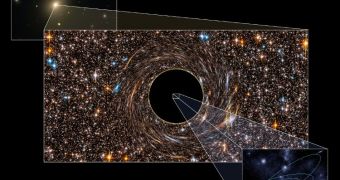A group of astronomers at the University of California in Berkeley (UCB), led by experts Chung-Pei Ma and Nicholas McConnell, announces the discovery of the largest black holes ever found. Each of the two objects is located at the heart of a massive elliptical galaxy.
The dark behemoths are so immense that they are accreting anything within a radius more than five times that of our own solar system. Each of them tips the scales at around 10 billion solar masses.
The previous record-holder in terms of mass was a black hole determined to weigh around 6 billion solar masses. The newly-found objects were found in galaxies located about 300 million light-years away from Earth.
Interestingly, the UCB team proposes that these black holes are the remnants of quasars, extremely powerful and bright galaxies that existed when the Universe was only a fraction of its current age.
As such, these objects may very well represent “the missing link between quasars and the supermassive black holes we see today,” explains Ma. The expert is a professor of astronomy at UCB, but also a theoretical astrophysicist at the university.
“In the early Universe, there were lots of quasars or active galactic nuclei, and some were expected to be powered by black holes as big as 10 billion solar masses or more,” the investigator goes on to say.
Unlike conventional black holes, supermassive ones are not produced directly from core-collapse supernovae. Rather, they are the result of billions of years of mergers and continuous growth. This can occur via destroying stars that happen to stray too close, or by gobbling up large gas clouds.
The new discovery may also be used to gain a deeper understanding of how host galaxies control the growth of supermassive black holes, and vice-versa. A link between the two processes has been proposed a long time ago, but deciphering its intricacies is proving to be very difficult.
Details of the new study will appear in the December 8 issue of the top scientific journal Nature. McConnell was the first author of the paper. Researchers at the University of Toronto, the University of Texas and the University of Michigan were also a part of the work.
Facilities belonging to the Arizona-based National Optical Astronomy Observatory (NOAO) were used to collect the necessary data.
One of the black holes is located in the elliptical galaxy NGC 3842 – itself some 320 million light-years away from Earth – and tips the scales at 9.7 billion solar masses. The other one is found in NGC 4889, a galaxy some 336 million light-years away, and is slightly larger than its counterpart.
“For comparison, these black holes are 2,500 times as massive as the black hole at the center of the Milky Way Galaxy, whose event horizon is one fifth the orbit of Mercury,” McConnell concludes.

 14 DAY TRIAL //
14 DAY TRIAL //